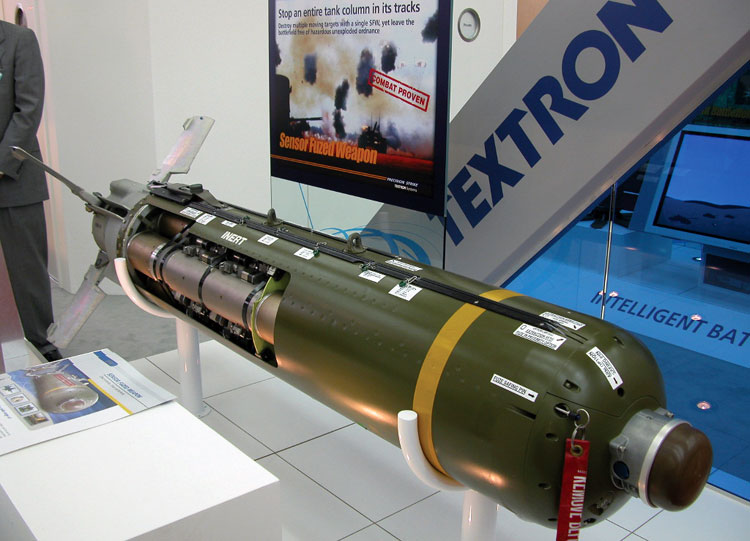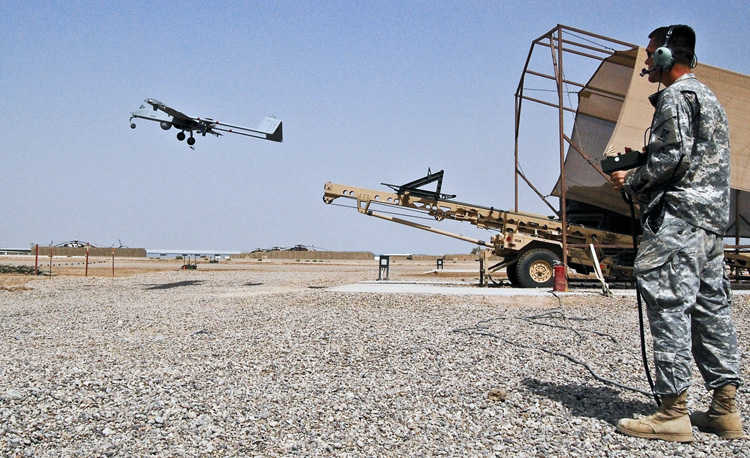- Prime Minister Narendra Modi inaugurates Aero India 2023 in Bengaluru; Releases Commemorative Stamp
- Defence Secretary meets delegations from Saudi Arabia, USA and Oman on the sidelines of Aero India 2023
- Foreign Ministers of 32 countries to attend Aero India 2023
- Embraer showcases the C-390 Millennium at Aero India 2023
‘We see the coming five years as being particularly focused on industrial partnerships that support licensed manufacturing and ToT’
Kevin J. Cosgriff , Senior Vice President, International Business and Government, Textron Systems Corporation

SP’s ShowNews (SP’s): Could you give brief details of Textron Systems' profile and its activities in India?
Kevin J. Cosgriff (Cosgriff): Tex tron Systems is uniquely positioned to support the Indian Government and its armed forces with systems critical to India’s defence and homeland security. These include:
- Our landing craft, air cushion (LCAC) has brought a range of mission capabilities to the US Navy since 1984.
- Our armoured security vehicle (ASV), with an operational readiness rate over 90 per cent, is heavily relied upon in Afghanistan and Iraq by the US Army as well as the Afghanistan National Army.
- Our shadow tactical unmanned aircraft systems coupled with our One System Ground Control Station has flown more than 7,00,000 hours, mostly in combat missions, with the US Army and Marine Corps.
- Our sensor fuzed weapon (SFW), of which 5,000 are in the US Air Force’s inventory, provides a solution to the unexploded ordnance (UXO) problem.
- Our cutting-edge Overwatch intelligence software that is the backbone of integrated ISR capabilities and is currently used by more than 37,000 analysts across the US intelligence agencies, military branches and unified commands.
Since 2007, Textron Systems’ activities in India are primarily focused on the development of the sensor fuzed weapon (SFW) programme in support of the Indian Air Force.
Sensor fuzed weapon is a combat proven and extensively tested air-delivered area weapon that provides a highly effective and reliable anti-vehicle weapon to the IAF. The SFW programme is a government-to-government transaction between India and the US, and was formally announced on December 8, 2010. We remain actively involved in the delivery of the system to the IAF.
Additionally, we have extended our support to the Indian Navy as it explores its requirements for hovercrafts. Textron Marine & Land Systems, an operating unit of Textron Systems, is the original manufacturer of the landing craft air cushion (LCAC), currently employed by the US and Japanese Navies.
Further, we are working with the Indian armed forces and important agencies, such as the Ministry of Home Affairs, the Defence Research and Development Organisation (DRDO) and the National Intelligence Grid, who have counter terrorism needs in the areas of tactical and geospatial intelligence solutions and unmanned aircraft systems (UAS)-both areas of expertise for Textron Systems. With extensive multi-source intelligence software solutions and a family of UAS, including ground control stations, we are able to bring a broad set of proven capabilities in support of their critical missions.

SP’s: Textron India Private Limited (TIPL) was reportedly established in Bangalore to carry out collaborative work on a wide range of engineering and design services. Could you give details of the work carried out by the TIPL in developing and creating innovative products and solutions for Textron Systems’ worldwide customers since its establishment in 2007?
Cosgriff: Textron India Private Limited was incorporated in 2004 as a strategic investment by Textron in India to support Textron’s businesses in the fields of engineering, business development and sourcing. Today, in our state-ofthe- art facility within Bangalore’s Global Village which includes electronics labs and space for a vehicle and mechanical engineering workshop, several hundred qualified engineers and professionals are working on complex engineering, aeronautical, industrial design, product and product management projects in support of our businesses.
SP’s: It is believed that the IAF has opted for the acquisition of substantial numbers of the Textron highly lethal sensor fused weapon-the CBU-105 cluster bomb? Could you give details of the weapon system including safety factors which help eliminate/minimise the chances of ‘unexploded ordnance’? Did TIPL have a role in the development of the said weapon system?
Cosgriff: The Indian Air Force is acquiring 512 sensor fuzed weapons from the US Government. SFW is an air-delivered area weapon that provides a highly effective and reliable anti-vehicle weapon to the IAF. Based on extensive testing and use in combat by the US Air Force, SFW is proven to leave less than one half a per cent unexploded ordnance (UXO). Additionally, the rare UXO left by SFW is safe to handle, as it cannot be detonated once it reaches the ground. At a 99.6 per cent proven reliability rate, SFW is one of the world’s most reliable and safest weapons. We see it as our responsibility to ensure our weapons complete their intended mission without leaving dangerous effects after a conflict, and have succeeded in doing so with SFW.
SFW achieves this by not using contact fuzing-the key feature that makes legacy cluster weapons dangerous and unsafe. Instead, SFW employs both active and passive sensors that search for and detect targets during flight, that precisely deliver munitions to intended armoured targets day or night and in all weather conditions. SFW also contains redundant self-destruction mechanisms. If SFW does not sense a target (a) within eight seconds or (b) upon reaching 50 feet (15.24 metres), its warheads self-destruct. Further, SFW contains a fail-safe self-neutralisation mechanism. SFW’s batteries carry only enough power to carry out its intended mission. Without this power, the SFW and its submunitions are rendered neutral in two minutes or less.
The Textron Systems India team is actively working with the Indian Air Force on the delivery of SFW and the integration of the system onto the Jaguar.

SP’s: What does Textron have to offer to India in the field of unmanned aerial systems (UAS), especially with its recent acquisition of AAI UAS now an operating unit of Textron Systems?
Cosgriff: Textron Systems and its AAI UAS business brings a wealth of ground control and UAS expertise to India, supporting border and port security as well as broader intelligence, surveillance and reconnaissance requirements. This includes the Universal Ground Control Station which based on the mature One System Ground Control Station used by the US Army, Army National Guard and Marine Corps, delivers the next generation of interoperability and flexibility to allow small teams to control multiple air, land and sea platforms serving various missions.
AAI UAS is also well known for its Shadow family of tactical unmanned aircraft systems (TUAS), including the US Army and Marine Corps cornerstone intelligence-gathering system, the Shadow 200, which has flown over 7,00,000 hours mostly in Iraq and Afghanistan.
SP’s: What methods are being adopted by Textron Systems to discharge its ‘offset’ responsibilities enshrined in the Defence Procurement Policy (DPP) vis-à-vis the sale of defence equipment in India? Please also comment on the industrial cooperation opportunities and your views on transfer of technology (TOT).
Cosgriff: Textron Systems, and our parent company Textron Inc., actively support development and trade in India as a close and important ally of the US. Since 2007, Textron India has led our work and growth in the region, including Textron’s Global Technology Centre in Bangalore that is home to local engineers that are a key part of our business development and engineering teams. Textron is also an active member of the US-Indian Business Council and regularly explores potential partnerships and teaming arrangements that would support our offset responsibilities as well as create greater industrial cooperation. The extent of ToT remains an open and active discussion.
For example, we have a positive relationship with HAL on the integration of SFW onto the Jaguar and have been in discussion with DRDO on other capabilities we could possibly bring to India.
We also continue to seek and plan the direct purchase and export of defence products and components manufactured by the Indian industry. We have identified partners such as QuEST Machining & Manufacturing, Aidin Technologies and Mahindra & Mahindra in our offset plans and will add more Indian suppliers to our plans going forward as we continue to evaluate new Indian sources.
SP’s: What are the Textron Systems future plans in India in the next plan period (2012- 17), especially in the field of ‘homeland security’ covering ‘site security programmes', ‘unmanned systems’ and ‘software solutions’?
Cosgriff: In the next five years, we will continue to support the Indian Government, its armed forces, and its security agencies as well as the local defence industry, addressing their requirements in the areas of unmanned systems, hovercraft, weapon systems and platform integration, and intelligence solutions for homeland security. We see the coming five years as being particularly focused on industrial partnerships that support licensed manufacturing and ToT.





